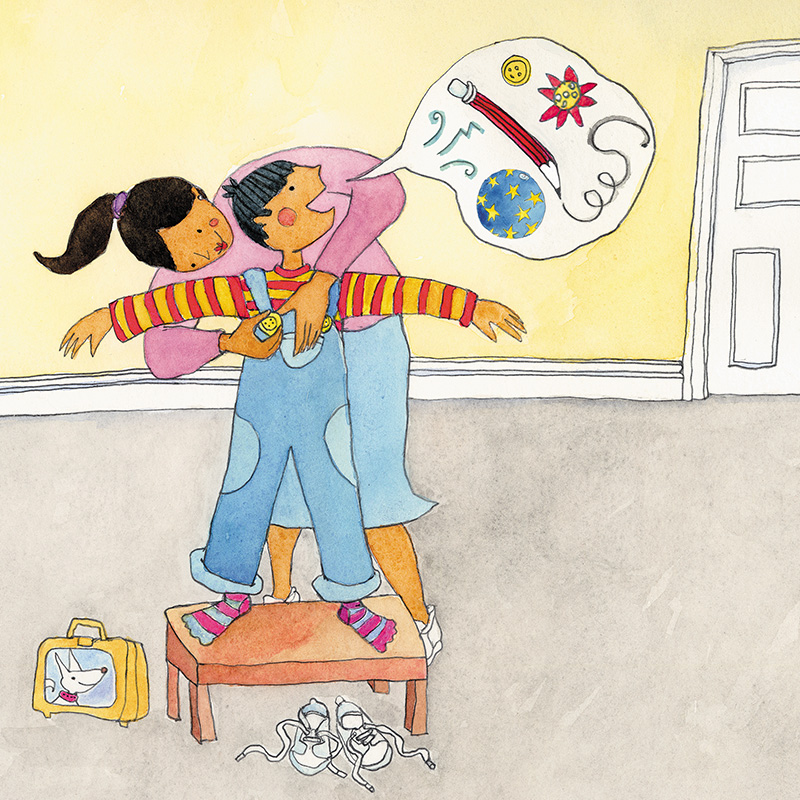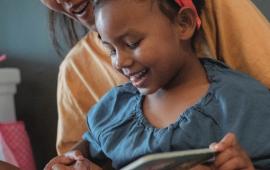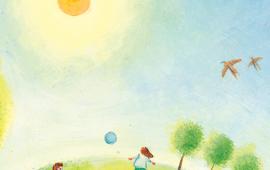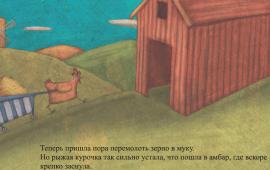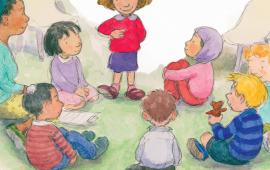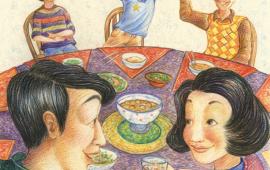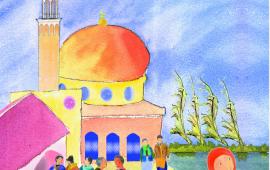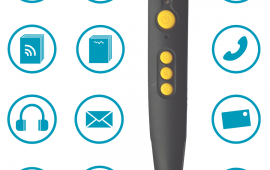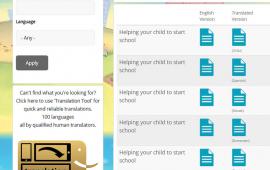Language sponges of the world unite – how effective are bilingual books in early years education?
You know that nagging suspicion we’ve always had that babies who are brought up bilingual from birth are actually, well, wired a little differently when it comes to acquiring languages? Well, it turns out we were absolutely correct – according to the Infant Speech Perception Lab at McGill University in Canada, anyway.
This is possibly, at least in part, because English is what’s known as a stress-timed language. In most two syllable English words, for instance, it’s the first syllable that is emphasised by native speakers. French, on the other hand, is what’s known as a syllable-timed language, where each syllable is given more or less the same amount of stress when the word is spoken. So even if the babies in Montreal didn’t know the words, he or she usually knew that a different language was being spoken, simply from the sounds and the rhythm.
Canada appears to be a good subject for these kinds of studies. The country has two official national languages. In a 2016 survey, just under 20% of households in Canada were reported as speaking more than one language in the home; in the previous year the percentage had been just under 18%.
Some researchers have found that bilingual children may associate one language with home and one with school. Some studies show how bilingual books in the early years can bridge this home-school connection. Picture books can also help to provide a context for learning new vocabulary and building on existing knowledge.
So with all of this in mind, bilingual books offer the perfect way to help your child or pupils acquire and practise both languages. There is evidence to show that bilingual books can help learners develop a range of life skills – including a creative approach to thinking as well as longer-term language retention.
As every language has its own rhythm, reading aloud in each language can help with fluency, as well as building confidence in speaking aloud to others or to an educator or parent.
Reading the tale of the Chinese Cinderella, for example, allows readers and listeners to draw comparisons and contrasts between the most common versions of the tale and the Chinese version. (Did you know that in the Chinese story, the shoe is made of gold, not glass? It’s still not a terribly practical substance for a garment that has to work so hard and is so important to the plot, but it would probably be very slightly more comfortable than glass, we suspect!)
Bilingual books also offer an excellent starting point for encouraging discussion about the characters and settings from a multicultural perspective. With the Chinese Cinderella, for instance, the children in the study enjoyed discussing how the dress that Yeh-Hsien wears is different from the gowns in other versions.
From the teacher’s perspective, comparing and contrasting the different versions that learners produce can be a very useful method of summative assessment. Analysing the results can help highlight any common problems with vocabulary, pronunciation, and listening, helping to inform lesson planning or generalised feedback at the end of a session, so feeding into a cycle of continuous improvement.
Bilingual approaches, including the use of bilingual books, can also be surprisingly helpful in the STEM curriculum, with particular applicability for developing creative thinking skills, pattern recognition, and problem-solving. Mathematics is another area where bilingual teaching methods have been shown to help – our theory is that maths shares many characteristics with language. In effect, it is an almost perfect international language, instantly recognisable around the world.
Since English remains, for now at least, the international language of science and healthcare, as well as of air traffic control and many other international situations. Using bilingual books or resources in STEM subjects can help students develop skills they are likely to need later in life.
So, while bilingual books are an excellent early years learning and teaching aid, and offer a gateway into the magic of stories, their effects are likely to be much longer lasting than you know.
Research into bilingualism
As soon as the medical professionals start getting involved, you know things are being taken seriously. Now, admittedly, the research so far has only involved 84 babies, and only looked at French/English bilingual children (in Montreal, in case you’re wondering about the location). Still, the findings make interesting reading. When a child heard two languages spoken by the same parent, for example, they could actually tell when the parent was speaking different languages.This is possibly, at least in part, because English is what’s known as a stress-timed language. In most two syllable English words, for instance, it’s the first syllable that is emphasised by native speakers. French, on the other hand, is what’s known as a syllable-timed language, where each syllable is given more or less the same amount of stress when the word is spoken. So even if the babies in Montreal didn’t know the words, he or she usually knew that a different language was being spoken, simply from the sounds and the rhythm.
Canada appears to be a good subject for these kinds of studies. The country has two official national languages. In a 2016 survey, just under 20% of households in Canada were reported as speaking more than one language in the home; in the previous year the percentage had been just under 18%.
Bilingual books for language learning
As yet, there is relatively little published research investigating the effectiveness of bilingual books for language learning, particularly in the early years. Although the principles should be applicable to most languages, a relatively large percentage of the published research that does exist seems to explore particular language pairs. Several studies examine English and Chinese, English and Spanish, or English and Polish. In general, the studies are small-scale, although there are a few exceptions.Some researchers have found that bilingual children may associate one language with home and one with school. Some studies show how bilingual books in the early years can bridge this home-school connection. Picture books can also help to provide a context for learning new vocabulary and building on existing knowledge.
So with all of this in mind, bilingual books offer the perfect way to help your child or pupils acquire and practise both languages. There is evidence to show that bilingual books can help learners develop a range of life skills – including a creative approach to thinking as well as longer-term language retention.
As every language has its own rhythm, reading aloud in each language can help with fluency, as well as building confidence in speaking aloud to others or to an educator or parent.
Building multicultural awareness with bilingual books
Developing multicultural awareness is another major advantage of using bilingual books with language learners, whether it’s in an EAL situation or in a situation where English is the mother tongue.Reading the tale of the Chinese Cinderella, for example, allows readers and listeners to draw comparisons and contrasts between the most common versions of the tale and the Chinese version. (Did you know that in the Chinese story, the shoe is made of gold, not glass? It’s still not a terribly practical substance for a garment that has to work so hard and is so important to the plot, but it would probably be very slightly more comfortable than glass, we suspect!)
Bilingual books also offer an excellent starting point for encouraging discussion about the characters and settings from a multicultural perspective. With the Chinese Cinderella, for instance, the children in the study enjoyed discussing how the dress that Yeh-Hsien wears is different from the gowns in other versions.
How can bilingual books support biliteracy?
From a practical language-learning point of view, bilingual books are an extraordinarily versatile prop. As well as facilitating listening, speaking and reading skills, bilingual books can be used in the classroom to encourage language learners to write their own versions, depending on the age of the child and the level of language development. This activity is suitable for individuals, pair work, or to encourage learners to work in groups, in either language, or in both.From the teacher’s perspective, comparing and contrasting the different versions that learners produce can be a very useful method of summative assessment. Analysing the results can help highlight any common problems with vocabulary, pronunciation, and listening, helping to inform lesson planning or generalised feedback at the end of a session, so feeding into a cycle of continuous improvement.
How can I use bilingual books to support the wider curriculum?
Bilingual books can also be used to support the wider curriculum, whether it’s in the arts, sciences, or humanities. One of the methods often suggested to support the wider curriculum is the immersion method, where classes are taught entirely in one of the target languages. While the dual language immersion method is not new – it was used in some areas in the late 1960s – it has enjoyed a slight resurgence in some places.Bilingual approaches, including the use of bilingual books, can also be surprisingly helpful in the STEM curriculum, with particular applicability for developing creative thinking skills, pattern recognition, and problem-solving. Mathematics is another area where bilingual teaching methods have been shown to help – our theory is that maths shares many characteristics with language. In effect, it is an almost perfect international language, instantly recognisable around the world.
Since English remains, for now at least, the international language of science and healthcare, as well as of air traffic control and many other international situations. Using bilingual books or resources in STEM subjects can help students develop skills they are likely to need later in life.
So, while bilingual books are an excellent early years learning and teaching aid, and offer a gateway into the magic of stories, their effects are likely to be much longer lasting than you know.
Further Reading
(Unless otherwise stated, all references were accessed on 7 August 2019)- Bialystok E. (2018). Bilingual education for young children: review of the effects and consequences. International journal of bilingual education and bilingualism, 21(6), 666–679, https://www.ncbi.nlm.nih.gov/pmc/articles/PMC6168086/
- Hu, R., Chen, X., & Li, X. (2012). Exploring Bilingual Books with Five Chinese First Graders: Children’s Responses and Biliteracy Development. Reading Horizons: A Journal of Literacy and Language Arts, 52 (1). https://scholarworks.wmich.edu/reading_horizons/vol52/iss1/4
- Ksenia S. Zhbanova (2019), Editorial: Developing Creativity through STEM Subjects Integrated with the Arts, Journal of STEM Arts, Crafts and Constructions 4 (1), https://scholarworks.uni.edu/cgi/viewcontent.cgi?article=1046&context=journal-stem-arts
- The amazing baby brain says 'pas de problème' with bilingualism (2019), The Conversation, 30 July 2019, https://www.bignewsnetwork.com/news/261898485/the-amazing-baby-brain-says-pas-de-problegraveme-with-bilingualism
- Yuan, S. (2019), Developing Students' Cultural Understanding in the Dual Language Immersion Program (excerpt), The University of North Carolina at Chapel Hill, ProQuest Dissertations Publishing, https://search.proquest.com/openview/11b5a4e35cda46aa74dd5904fcca07d2/1?pq-origsite=gscholar&cbl=18750&diss=y
- Zhang, Z. and Webb, S. (2019), The effects of reading bilingual books on vocabulary learning, Reading in a Foreign Language 31 (1), http://nflrc.hawaii.edu/rfl/April2019/April2019/articles/zhang.pdf
Related Posts
-
Mind Your Language - A Note On the UN's International Literacy Day 2019
-
Bird Brains And Other Wildlife - The Next RSPB Birdwatch Is Heading Our Way...
-
9 Benefits of Reading to Children
-
And a very merry May Day to you too – some Mayday and Beltane celebrations and traditions
-
The Latest British Council report reveals struggle of language learners in the UK. Can bilingual books help?
-
Breaking The Ice On Your First Day At School
-
Not Everyone Celebrates New Year on 1 January....
-
Ramadan Begins!
-
A new kind of PENfriend – Mantra Lingua’s new digital device to help make sense of the world all around you
-
Do You Speak This Language? The Mantra Lingua L1 Key Terms & Letters Library

